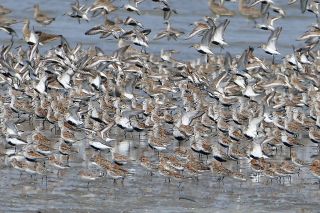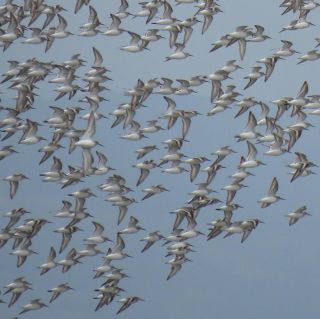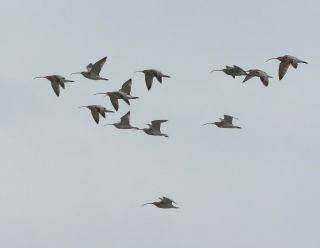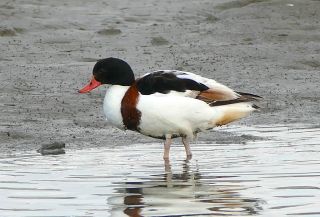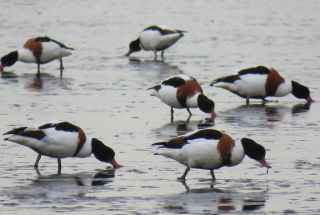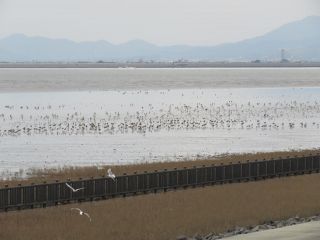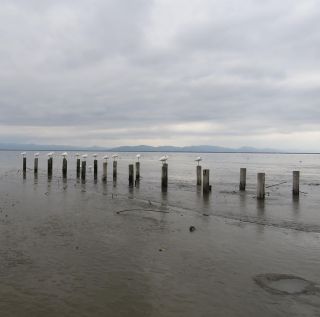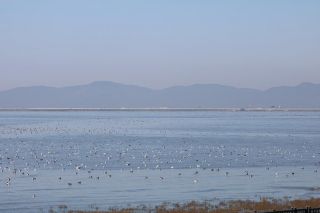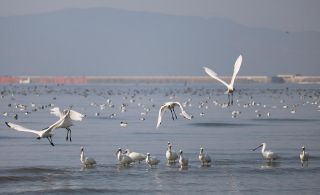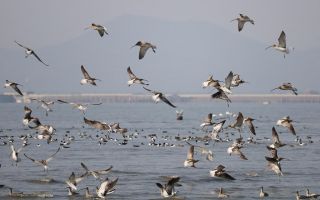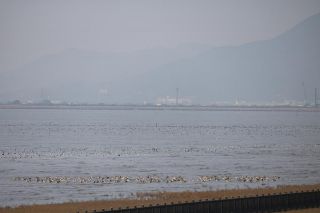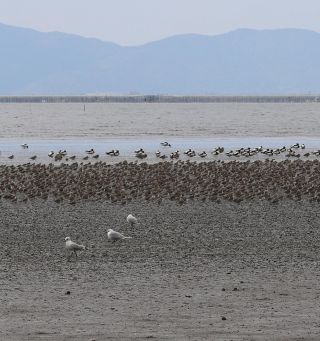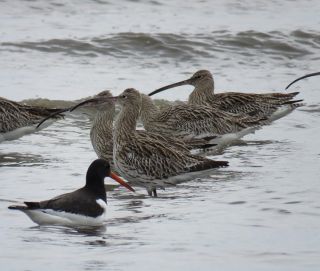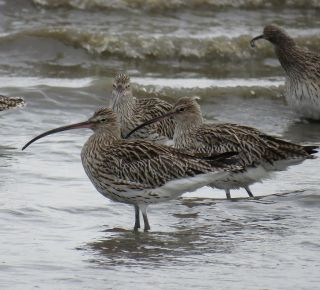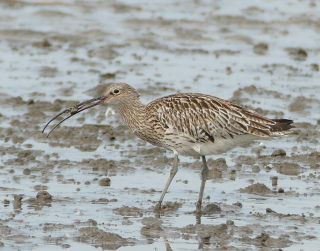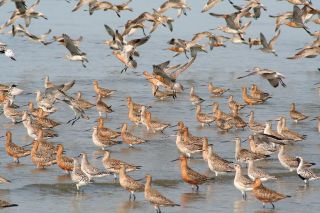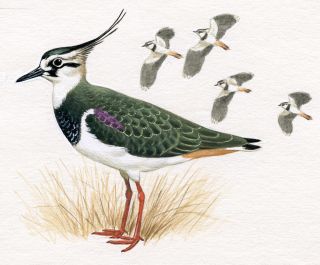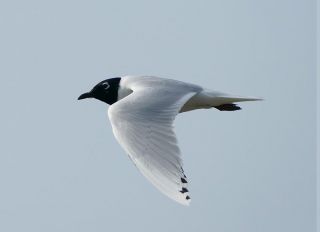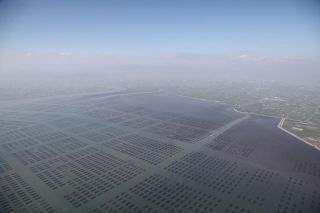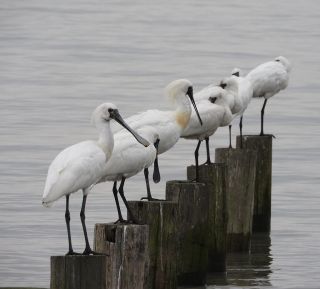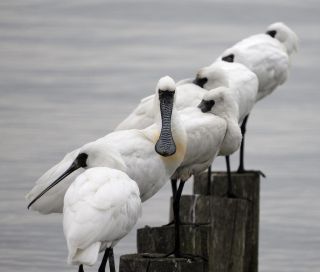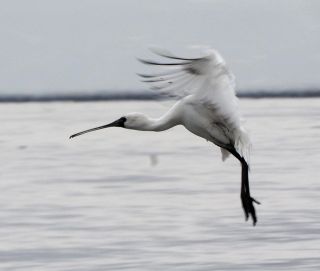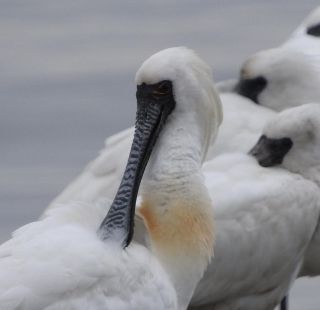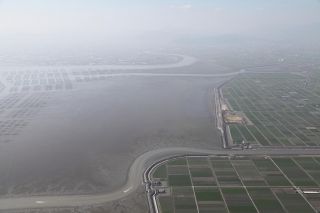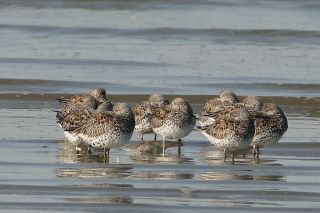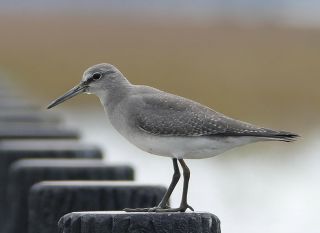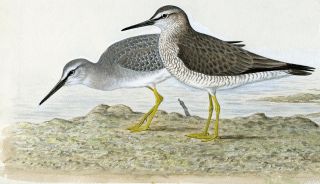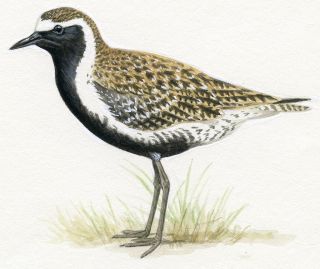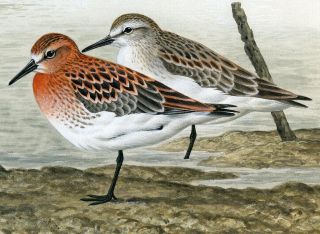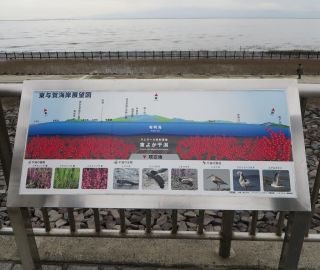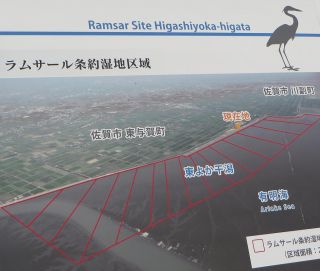Dunlin on the move, here in breeding plumage showing off their black belly patches © Sayaka Nakamura
Daijugarami: Stepping Stone to the Arctic
By Mark Brazil | Apr 27, 2016
It was the middle of the night and I was miserably cold; it was after all still March, and in the darkness the loneliness of the long-distance hitchhiker had descended upon me again, this time in northern Kyushu, Japan. That lonely night brought back to mind haunting memories of yet earlier nights, nights when as an undergraduate student in England I had braved wind and rain in my regular attempts to hitchhike across country from Staffordshire to Norfolk. Hitchhiking along major thoroughfares in the UK was one thing, but attempting to go across country on relatively minor roads in the 1970s was something entirely different. Slow, wet, and lonely, doesn’t even begin to describe the experience, and there I was, reliving those nightlong English journeys by doing something very similar, travelling across Japan alone and at night in an attempt to reach the Ariake Sea, from Zushi, in Kanagawa Prefecture. I was travelling on a shoestring budget using a combination of shanks’ pony and hitchhiking. I should make it clear; this late March journey was itself a long time ago – back in 1983 no less. My undergraduate days had passed, I had even completed my doctorate, but I was wandering, exploring, and still looking for direction. I can’t say that I found direction on that March journey, but I did find some extraordinarily good birds for that decade in Japan.
On 19 March 1983, I had been fortunate to see a Greater Yellowlegs, a vagrant shorebird from North America, which had spent part of the winter at Matsunaga Bay in Okayama Prefecture. With that success under my belt I was unwilling to rest there. I had heard further news of good birds further south, in Kyushu. So it was that I continued hitchhiking, through the night, bound for Saga Prefecture and the Ariake Sea. Actually, I seemed to do more hiking than anything that night, as cars were few and far between. During the very cold midnight hours I began to think of finding a place to unfurl my sleeping bag and catch a few hours sleep. This was my second night on the road and lying horizontally anywhere, was a very tempting thought.
I was just about to put down my backpack when I saw distant lights. One last chance, I thought. I held out my thumb yet again, set a rather road-weary smile on my face (perhaps a rather pointless gesture given the darkness) and hoped. Amazingly, a very new 4x4 stopped and a fashionably dressed fellow beckoned me in to the welcoming warmth and comfort of his vehicle. He astonished me by speaking in near flawless English, and instead of falling asleep from exhaustion I found myself drawn in to a rather fascinating conversation focussing on international travel. He quickly found out about me and what I was up to in southern Japan, and I was soon astonished by the extent of his travels and to hear that his first foreign language was actually Spanish, not English.
My first attempt to find out what he did was met with a shrug and an evasive “a bit of this and a bit of that”. The conversation moved on, but twice more during the night I attempted to draw him out. On the second occasion, he admitted that his business “involved buying and selling”. Later still, when I tactlessly enquired of him a third time he didn’t deign to verbalise his reply, instead he just held up his left hand. I was only briefly puzzled, it wasn’t the gesture I had expected; then I clocked the fact that not one, but two joints of his left little finger were missing! Slowly, very slowly, all of the facts were coalescing in my sleep-starved brain. Not only was this young Japanese man fashionably dressed and driving a fancy foreign car at night, but also he spoke Spanish and English fluently and had travelled extensively and repeatedly in South America. Furthermore, he had performed the yubitsume (self amputation) apology twice. He was no ordinary fellow making ends meet by doing “a bit of this and a bit of that”, he was a member of the yakuza! I could imagine that he was probably involved in the international drug trade, but I didn’t even want to imagine what mistakes he had made that had led to his particularly painful penance to his boss.
Despite his shady occupation he was well spoken, courteous and kindly gave me a long lift to the southern outskirts of Saga, but I wasn’t sorry to say goodbye to my tangential link to shady dealings. I traded them for the darkness of the night. I put my pack on my back and set of walking. I walked southwards for over three hours, hoping I was heading in the right direction for a place I only knew as “Daijugarami,” on the northern shore of the Ariake Sea.
The enormous Ariake Sea is actually the largest bay in Kyushu; it is like a huge bite out of the western part of the island and lies between Nagasaki and Kumamoto and south of Saga. Its vast grey, tidal mudflats are vital resting and foraging sites, essentially refuelling stations, for migratory shorebirds and waterfowl.
The mudflats of the Ariake-kai have long been utilised by local people as shell fishing grounds while the shallow waters of the bay (nowhere is it more than 50 m deep) have been widely utilised for the cultivation of nori seaweed. I was heading there for the shorebirds of course, not for the nori.
I had heard that the muddy coast of the Ariake-kai abounded in shorebirds and that the reclaimed lands around its margins often hosted unusual overwintering birds. The information I had received was spot on. What a day I had. Even before dawn I heard my first Eurasian Magpies, then shortly after 06:00 I encountered a roost of nearly 120 of them in one tree. They seemed to be in every village and around each farm; many were already nesting having built their untidy spherical nests atop telegraph poles as well as trees. I watched a Merlin, a small falcon, hunting low and fast across the fields, its prey an unfortunate Dusky Thrush. I found a Ruddy-breasted Crake poking about in a dyke behind the seawall, and saw a Chinese Grey Shrike and many other tempting avian distractions, but it was the shorebirds that had brought me to Daijugarami. They weren’t there in quite the numbers I had hoped for, I was a few weeks early, but nevertheless I was thrilled to see them.
A swarm of birds, twisting and turning in flight, flashed from grey to white as they banked and turned out over the bay. They were as restless as the tide they followed, sometimes rising into the air like a swarm of bees, sometimes spiralling down to rest briefly on the mud. They were hesitant, nervous and quick to take to the wing again; grey against the grey sky, then suddenly white again as they banked and revealed their pale, winter plumage underparts. The presence of birds of prey in the area may have spooked them, or perhaps it really was just the tide that had them unsettled. When they finally relaxed, landed and began foraging, they probed at the mud hurriedly clearly hungering for food. They were too far away for me to see their prey, but as they were Dunlin I knew that in all likelihood they were finding minute shellfish in the surface mud. As I scanned with my telescope I encountered other species too, sandpipers, plovers, tattlers, godwits, curlews, and snipe; all of them enjoying the bounty offered up by the mud.
Shorebirds are an amazing group of species. Where we see unbroken expanses of mud they see opportunity, and dinner. Where we see uniformity in the mudflat, they see variations in mud density, mud hardness, and the amount of sand or the lack thereof. Where we look for food with our eyes, many of them probe and drill at the mud finding their food by touch – their bills are remarkably sensitive.
Between them, the different groups of shorebirds divide up their environment, not as we might, by saying you look for food over there and I’ll look over here and lets keep out of each others way, but in their adaptations to different styles of foraging. The large-eyed plovers, such as the Pacific Golden Plover and Black-bellied Plover, pace along elegantly then nod and bow at the mud. They spot their prey by eye; then pick it swiftly from the surface with their short, stubby bills. I saw them both there that day in March 1983.
The curlews and godwits, with their enormously elongated bills, probe deeply beneath the surface; they drill down as if prospecting, I suppose that in a way they are. The Far Eastern Curlew and the Common Curlew, both with improbably long bills that curve down distinctly at the tip, and their smaller curve-billed cousin the Whimbrel, each probe to different depths in the mud feeling for mud worms and shellfish as they go. Bar-tailed Godwits with their long straight, ever so slightly up tilted bills probe in and in, sometimes moving around one spot aggressively in pursuit of deeply hidden prey. The ever-busy flocks of Dunlin probe just below the surface and the even shorter-billed Red-necked Stint barely dips its bill beneath the surface of the wet mud.
Between them, their adaptations allow shorebirds to partition their muddy habitat into separate niches; each in its own way is benefitting from the presence of the other birds, but without competing with them for food. Some prefer the sloppiest, wettest mud that has been most recently exposed by the retreating tide. Others prefer the drying mud from which the tidewater is draining, while others such as the Northern Lapwing are at home on dry mud or even damp meadows, pastures and post-harvest paddy fields. On that March morning I watched a flock of ten lapwings that took wing and passed overhead, they called plaintively and were all a flutter like large black and white butterflies, their rounded wings flickering and flipping them on the light wind that afternoon.
Almost all of the events of that day in 1983 had faded from my memory save for my meeting with that member of the mafia, but suddenly, this March, 33 years later, the memories came pouring back. The occasion that spurred that recall was a scouting trip in Kyushu at the invitation of Saga Prefecture and JTB Kyushu, during which I was delighted to be shown two new Ramsar Sites (wetlands recognised internationally as of global significance). The first, Hizen Kashima Higata, was close to Kashima City, but alas the weather on 9 March 2016 was not in our favour. The tide was already in when we arrived and the shorebirds had already left for their high tide roost, furthermore it was raining as if to remind us of the rainy season yet to come. The strength of the downpour forced us to retreat indoors, though not before I had seen an astonishing number (at least to me) of Common Shelduck and Saunders’s Gulls. I estimated that at least 600 shelduck were out on the bay. This plump, goose-sized duck is attractively patterned in white, chestnut, and bottle green. With its bright red bill it shuffles forwards on the wet mud sieving away at the surface for food. Meanwhile I counted at least 350 of the gulls. The rare Saunders’s Gull, a bird highly restricted in a very limited East Asian range, searches in flight for its prey, quartering back and forth over the tide edge and wet mud, then suddenly it twists in the air, and drops to snatch a small crab from the surface before it can escape into its burrow. I was delighted to see both species, but I was itching to see shorebirds.
Although a leaden sky greeted me on 10 March, at least it was no longer raining and a visit to Higashiyoka Tidal Flat was still on the cards. As we arrived I realised that the tide was very high and pushing up birds closer and closer to the edge of the mud and the seawall, the action was at its peak. I was eager to get in close and admire the mixed flocks of birds through my telescope, and perhaps even to photograph them. A group of the extremely rare Black-faced Spoonbills was gathering at their high tide roost on wooden poles jutting from the mud. They were so close I could make out the strange ridges across their bills and the tiny patch of black skin that extends between bill and eye that is crucial in recognising this species. I couldn’t believe my luck.
Under such circumstances it was difficult to pay attention also to the various city officials and invitees there to meet me, but one person who stood out from the crowd with her charming smile and keen interest in everything avian was Mrs Sayaka Nakamura. Together we watched her favourite birds, the shorebirds, whirling and swirling in flocks about us and over the bay. There were hundreds of Common Curlews, dozens of Far Eastern Curlews, several hundred Dunlins and lesser numbers of a whole range of other shorebirds including at least four Long-billed Dowitchers (a scarce winter visitor to Japan from its breeding grounds in northeast Chukotka, Russia). As we talked, Nakamura-san mentioned that her husband was the schoolboy who had joined me on a survey of Saunders’s Gull habitat back in the 1990s; what a small world! As we talked, more and more spoonbills were arriving until 16 of them were roosting right in front of us. I could see the ridging on their bills, the colour of their eyes and the yellowing neck plumes that presaged their breeding season. The tide-filled waters of the bay were now carpeted with shelduck, perhaps as many as a thousand, and large numbers of gulls. I could easily have spent all day there marvelling over the migrants.
Flocks of shorebirds are mesmerising. They are in constant motion and continuously keeping up soft contact calls, or stronger whistled calls as the flocks break apart, coalesce, lurch off in a new direction only to swarm back again moments later. The shorebirds seem so much a part of muddy estuaries and coastal wetlands, yet in reality they are birds of the Arctic.
These wading birds are long-distance migrants spending their summers high in the Arctic on coastal and upland tundra then, after breeding, heading south to winter in the southern hemisphere. Wetlands, such as those in southern Japan, are largely used by birds passing through on migration, though some of the hardier ones linger during winter. Typically though the shorebirds spend only a few days or weeks there as they refuel and rest. Soon they are eager to continue to their distant destinations. As I watched them whirling above the bay, I could only imagine their journeys.
Some of those birds were record-breakers of the avian world. The Black-bellied (or Grey) Plover for example, with its delightfully spangled silver and black back pattern in its breeding finery and a jet-black face, throat, chest and belly, makes a migration that is truly astounding. On-going satellite tracking of birds caught recently in Australia shows that as I write they have reached southern China (by way of Borneo) and are heading north towards the Yellow Sea, the Korean Peninsula and Japan, on their way to the Arctic. Satellite telemetry is allowing us insights into the incredible world of birds that we could only guess at before.
The closely related Pacific Golden Plover, spangled with gold above, also makes a similarly impressive migration, but it is the Bar-tailed Godwit that now holds the record. This godwit is a deep chestnut-coloured long-legged wading bird that holds the current world record for non-stop flight. In spring, they travel northwards visiting wetlands along the Asian coast, such as those in Kyushu, refuelling at more than one wetland before reaching their high Arctic breeding grounds in northeast Russia and northwest Alaska. It is their return journey though that is so astounding. Individuals have been tracked leaving their Alaskan breeding grounds and flying without a break to their wintering grounds 11,500 km away – in New Zealand! What an incredible feat that is. One bird was tracked making that journey in nine days, and that is without stopping to feed or rest. It is akin to us running non-stop marathons for days on end without eating, drinking or sleeping. Such amazing flights are only possible because birds have a wonderfully insulating feather coat that protects them from the low temperatures they experience in their high altitude flight and because they are able to store sufficient fat prior to migration. They can burn that stored fat so efficiently in flight, producing the energy, heat and the moisture they need, that they can survive what would be an otherwise impossible journey. By the time they arrive on their wintering grounds they are drained, exhausted, and may have lost half of their body weight.
As I watched the shorebirds of Higashiyoka with Nakamura-san in March this year, I couldn’t help remembering my first visit to Saga Prefecture and wondering just how far away I was from that site that I had first reached by hitch-hiking in the early 1980s. I asked her if she knew the place and was amazed by her answer – “this is it, its other name is Daijugarami”. After 33 years I had returned. It was so different, and yet in many ways so much the same. Where I had encountered flocks of magpies then, this year I was hard pressed to find even one pair and saw only one nest; they have lost out to the Large-billed Crows. Where I had found only narrow lanes, tracks, dykes and a deserted rough seawall, now there are roads, a park and visitor information enticing tourists to stop by and admire the birds. I recognised none of it. Judging by the number of photographers lined up in front of the spoonbills, this site is well known and much watched. The more watchers the better, they may help to protect it and the marvellous birds it supports.
Now, in spring, the shorebirds are on their way northwards again, using the surviving coastal wetlands of Asia as their stepping-stones to the Arctic. They are moving up the islands, stopping in Okinawa, in Kyushu, at sites such as Hizen Kashima Higata and Higashiyoka, and at sites further north in Honshu. These sites are precious ecological links in a chain supporting long distance migratory birds, protecting these sites under the RAMSAR convention is a marvellous first step, we just need many more sites like them to ensure the survival of some of the most extreme athletes on Earth – the shorebirds.
Outro
If you have read this far, then you may enjoy my previous articles, including recent offerings such as: Whale Watching Japan-style: Zamami (March 2016), Snow Monkeys & Cranes of Japan: Spectacular Winter Wildlife (February 2016), Amami Night Safari (January 2016), Life at the Water’s Edge (December 2015), and The Bird that Saved Me from Death (November 2015). These and many more can be found on this website, and on our Facebook page (please do visit and hit the “Like” button).
Author and naturalist Dr Mark Brazil has written his Wild Watch column continuously since April 1982. All Wild Watch articles dating back to 1999 are archived here for your reading pleasure. A collection of Mark’s essays The Nature of Japan and two handy pocket guides The Common and Iconic Birds of Japan and The Common and Iconic Mammals of Japan have been published and are also available from www.japannatureguides.com

